 |
VMS DECwindows Guide to Xlib (Release 4)
Programming: MIT C Binding
6.4 Drawing Rectangles and Arcs
As with routines that draw points and lines, Xlib provides clients the
choice of drawing either single or multiple rectangles and arcs. If a
client is drawing more than one rectangle or arc, use the
multiple-drawing routines for most efficiency.
6.4.1 Drawing Rectangles
To draw a single rectangle, use the DRAW RECTANGLE routine, specifying
the coordinates of the upper left corner and the dimensions of the
rectangle, as in the following:
int x=50
int y=100;
int width=25;
int length=50;
.
.
.
XDrawRectangle(display, window, gc, x, y, width, length);
|
Figure 6-3 illustrates how Xlib interprets coordinate and dimension
parameters. The x- and y-coordinates are relative to the origin of the
drawable.
Figure 6-3 Rectangle Coordinates and Dimensions
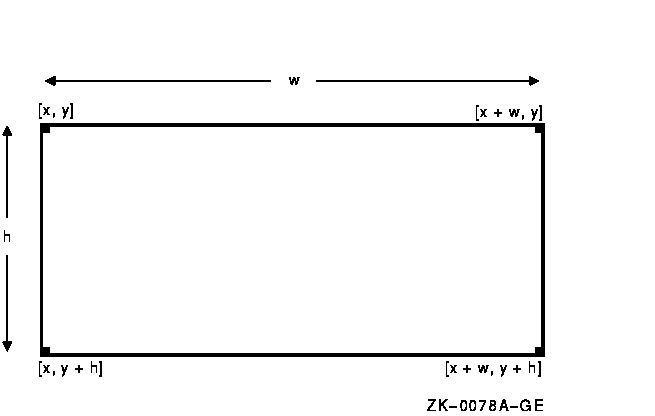
To draw multiple rectangles, use the following method:
- Define an array of rectangles using the rectangle data structure.
- Call the DRAW RECTANGLES routine, specifying the array that defines
rectangle origin, width, and height, and the number of array elements.
The server draws each rectangle as shown in Figure 6-4.
Figure 6-4 Rectangle Drawing
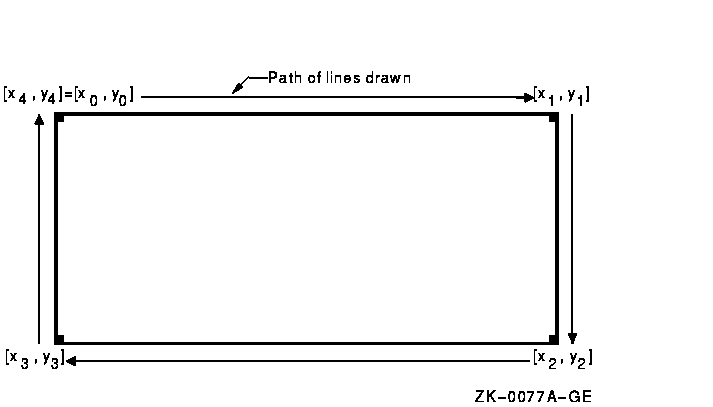
For a specified rectangle, the server draws each pixel only once. If
rectangles intersect, the server draws intersecting pixels multiple
times.
Xlib includes the rectangle data structure to enable clients to define
an array of rectangles easily. The following illustrates the data
structure:
typedef struct {
short x, y;
unsigned short width, height;
} XRectangle;
|
Table 6-3 describes the members of the rectangle data structure.
Table 6-3 Rectangle Data Structure Members
| Member Name |
Contents |
|
x
|
Defines the x value of the rectangle origin
|
|
y
|
Defines the y value of the rectangle origin
|
|
width
|
Defines the width of the rectangle
|
|
height
|
Defines the height of the rectangle
|
When drawing either single or multiple rectangles, the server refers to
the following members of the GC data structure to define rectangle
characteristics:
|
Function
|
Plane mask
|
|
Foreground
|
Background
|
|
Line width
|
Line style
|
|
Join style
|
Fill style
|
|
Tile
|
Stipple
|
|
Tile/stipple x origin
|
Tile/stipple y origin
|
|
Subwindow mode
|
Clip x origin
|
|
Clip y origin
|
Clip mask
|
|
Dash offset
|
Dashes
|
Chapter 4 describes the GC data structure members.
Example 6-3 illustrates using the DRAW RECTANGLES routine.
Figure 6-5 shows the resulting output.
| Example 6-3 Drawing Multiple Rectangles |
.
.
.
/***** Handle events *****/
static void doHandleEvents( )
{
XEvent event;
for ( ; ; ) {
XNextEvent(dpy, &event);
switch (event.type) {
case Expose: doExpose(&event); break;
case ButtonPress: doButtonPress(&event); break;
}
}
}
/***** Write a message *****/
(1)static void doExpose(eventP)
XEvent *eventP;
{
char message1 [ ] = {"To draw multiple rectangles, click MB1"};
char message2 [ ] = {"To exit, click MB2"};
XDrawImageString(dpy, win, gc, 150, 25, message1, strlen(message1));
XDrawImageString(dpy, win, gc, 150, 50, message2, strlen(message2));
}
/***** Draw the rectangles *****/
static void doButtonPress(eventP)
XEvent *eventP;
{
#define REC_CNT 40
#define STEP 15
XRectangle rec_arr[REC_CNT];
int i;
(2) if (eventP->xbutton.button == Button2) sys$exit (1);
for (i=0;i<REC_CNT;i++) {
rec_arr[i].x = STEP * i;
rec_arr[i].y = STEP * i;
rec_arr[i].width = STEP*2;
rec_arr[i].height = STEP*3;
}
(3) XDrawRectangles(dpy, win, gc, &rec_arr, REC_CNT);
}
|
- When the client receives notification that
the server has mapped the window, the doExpose routine writes
two messages into the window. For information about using the DRAW
IMAGE STRING routine, see Chapter 8.
- If the user clicks any mouse button, the
client calls the doButtonPress routine. If the user clicks
MB1, the client draws rectangles defined in the initialization loop. If
the user clicks MB2, the client exits the system. The client determines
which button the user has clicked by referring to the button member of
the button event data structure. For more information about the button
event data structure, see Chapter 9.
- The DRAW RECTANGLE routine has the following
format:
XDrawRectangles(display, drawable_id, gc_id, rectangles,
num_rectangles)
|
Figure 6-5 Rectangles Drawn Using the DRAW RECTANGLES
Routine
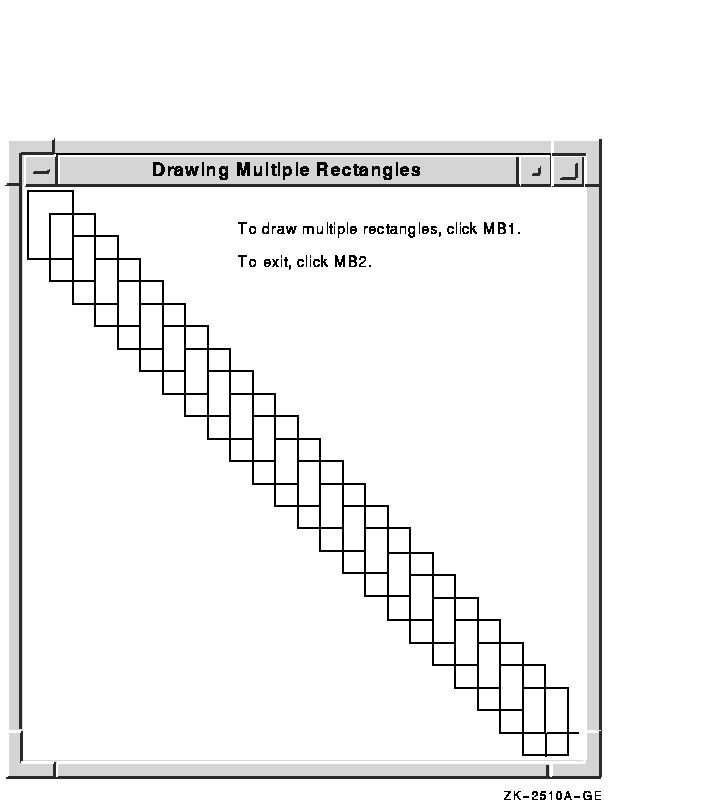
6.4.2 Drawing Arcs
Xlib routines enable clients to draw either single or multiple arcs. To
draw a single arc, use the DRAW ARC routine, specifying a rectangle
that defines the boundaries of the arc and two angles that determine
the start and extent of the arc, as in the following:
int x=50
int y=100;
int width=25;
int length=50;
int angle1=5760;
int angle2=5760;
.
.
.
XDrawArc(display, window, gc, x, y, width, height,
angle1, angle2);
|
The server draws an arc within a rectangle. The client specifies the
upper left corner of the rectangle, relative to the origin of the
drawable. The center of the rectangle is the center of the arc. The
width and height of the rectangle are the major and minor axes of the
arc, respectively.
Two angles specify the start and extent of the arc. The angles are
signed integers in degrees scaled up by 64. For example, a client would
specify a 90-degree arc as 64*90 or 5760 . The start of the arc is
specified by the first angle, relative to the three o'clock position
from the center of the rectangle. The extent of the arc is specified by
the second angle, relative to the start of the arc. Positive integers
indicate counterclockwise motion; negative integers indicate clockwise
motion.
To draw multiple arcs, use the following method:
- Define an array of arc data structures.
- Call the DRAW ARCS routine, specifying the array that defines the
arcs and the number of array elements.
The following illustrates the arc data structure:
typedef struct {
short x, y;
unsigned short width, height;
short angle1, angle2;
} XArc;
|
Table 6-4 describes the members of the arc data structure.
Table 6-4 Arc Data Structure Members
| Member Name |
Contents |
|
x
|
Defines the x-coordinate value of the rectangle in which the server
draws the arc
|
|
y
|
Defines the y-coordinate value of the rectangle in which the server
draws the arc
|
|
width
|
Defines the major axis of the arc
|
|
height
|
Defines the minor axis of the arc
|
|
angle1
|
Defines the starting point of the arc relative to the 3-o'clock
position from the center of the rectangle
|
|
angle2
|
Defines the extent of the arc relative to the starting point
|
When drawing either single or multiple arcs, the server refers to the
following members of the GC data structure to define arc
characteristics:
|
Function
|
Plane mask
|
|
Foreground
|
Background
|
|
Line width
|
Line style
|
|
Join style
|
Cap style
|
|
Fill style
|
Tile
|
|
Tile/stipple x origin
|
Tile/stipple y origin
|
|
Clip x origin
|
Clip y origin
|
|
Clip mask
|
Dash offset
|
|
Dashes
|
Stipple
|
|
Subwindow mode
|
|
Chapter 4 describes the GC data structure members.
If the last point in one arc coincides with the first point in the
following arc, the two arcs join. If the first point in the first arc
coincides with the last point in the last arc, the two arcs join.
If two arcs join, the line width is greater than zero, and the arcs
intersect, the server draws all pixels only once. Otherwise, it may
draw intersecting pixels multiple times.
Example 6-4 illustrates using the DRAW ARCS routine.
| Example 6-4 Drawing Multiple Arcs |
.
.
.
/***** Handle events *****/
static void doHandleEvents( )
{
XEvent event;
for ( ; ; ) {
XNextEvent(dpy, &event);
switch (event.type) {
case Expose: doExpose(&event); break;
case ButtonPress: doButtonPress(&event); break;
}
}
}
/***** Write a message *****/
static void doExpose(eventP)
XEvent *eventP;
{
char message1[ ] = {"To create arcs, click MB1"};
char message2[ ] = {"Each click creates a new circle of arcs."};
char message3[ ] = {"To exit, click MB2"};
XDrawImageString(dpy, win, gc, 150, 25, message1, strlen(message1));
XDrawImageString(dpy, win, gc, 150, 50, message2, strlen(message2));
XDrawImageString(dpy, win, gc, 150, 75, message3, strlen(message3));
}
/***** Draw the arcs *****/
static void doButtonPress(eventP)
XEvent *eventP;
{
#define ARC_CNT 16
#define RADIUS 50
#define INNER_RADIUS 20
XArc arc_arr[ARC_CNT];
int i;
(1) int x = eventP->xbutton.x;
int y = eventP->xbutton.y;
if (eventP->xbutton.button == Button2) sys$exit (1);
for (i=0;i<ARC_CNT;i++) {
arc_arr[i].angle1 = (64*360)/ARC_CNT * i;
arc_arr[i].angle2 = (64*360)/ARC_CNT*3;
arc_arr[i].width = RADIUS*2;
arc_arr[i].height = RADIUS*2;
arc_arr[i].x = x - RADIUS + sin(2*3.14159/ARC_CNT*i) * INNER_RADIUS;
arc_arr[i].y = y - RADIUS + cos(2*3.14159/ARC_CNT*i) * INNER_RADIUS;
}
(2) XDrawArcs(dpy, win, gc, &arc_arr, ARC_CNT);
}
|
- The x and y variables
specify the upper left corner of the rectangle that defines the
boundary of the arc. The client determines the rectangle coordinates by
taking the values of the x and y
arguments from the button event data structure. Because these values
indicate the position of the cursor when the user clicks the mouse
button, the server draws the arcs relative to the position of the
cursor. For more information about the button event data structure, see
Chapter 9.
- The DRAW ARCS routine has the following
format:
XDrawArcs(display,drawable_id,gc_id,arcs,num_arcs)
|
Figure 6-6 illustrates the resulting output.
Figure 6-6 Multiple Arcs Drawn Using the DRAW ARCS
Routine
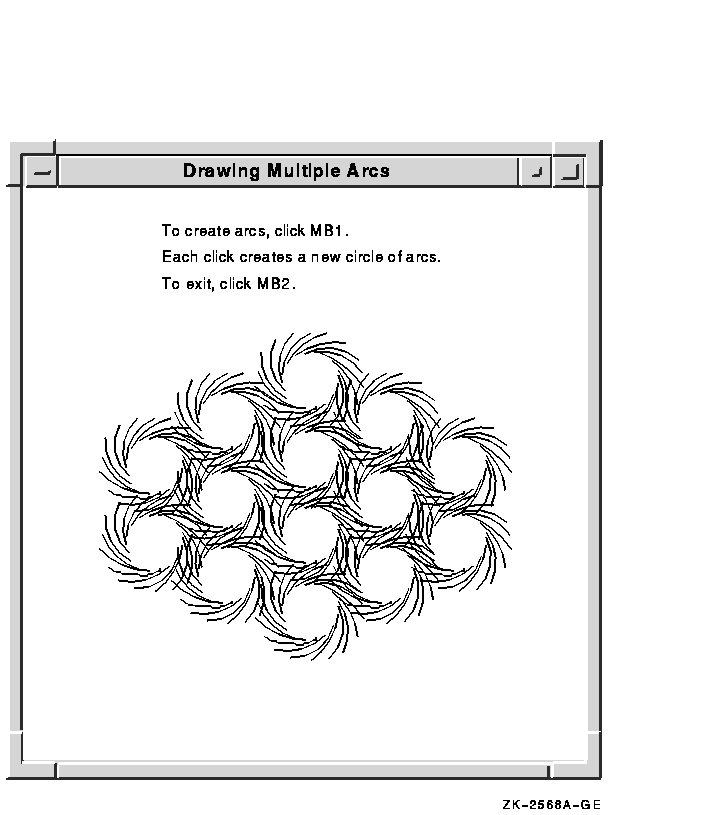
6.5 Filling Areas
This section describes using Xlib routines to fill single rectangles,
arcs, and polygons, and multiple rectangles and arcs.
6.5.1 Filling Rectangles and Arcs
The FILL RECTANGLE, FILL RECTANGLES, FILL ARC, and FILL ARCS routines
create single and multiple rectangles or arcs and fill them using the
fill style that the client specifies in a graphics context data
structure.
The method of calling the fill routines is identical to that for
drawing rectangles and arcs. For example, to create rectangles filled
solidly with foreground color in Example 6-3, the client needs only
to call the FILL RECTANGLES routine instead of DRAW RECTANGLES. The
default value of the GC data structure fill style member is solid. If
the client were to specify a tile or stipple for filling the
rectangles, the client would have to change the graphics context used
by the FILL RECTANGLES routine.
The server refers to the following members of the GC data structure to
define characteristics of the rectangles and arcs it fills:
|
Function
|
Plane mask
|
|
Foreground
|
Background
|
|
Fill style
|
Tile
|
|
Stipple
|
Subwindow mode
|
|
Tile/stipple x origin
|
Tile/stipple y origin
|
|
Clip x origin
|
Clip y origin
|
|
Clip mask
|
|
Additionally, the server refers to the arc mode member if filling arcs.
For information about using graphics context, see Chapter 4.
6.5.2 Filling a Polygon
To fill a polygon, use the following method:
- Define an array of point data structures.
- Call the FILL POLYGON routine, specifying the array that defines
the points of the polygon, the number of points the server is to draw,
the shape of the polygon, and the coordinate system the server is to
use. The server draws the points in the order specified by the array.
See Section 6.3.1 for an illustration of the point data structure.
To improve performance, clients can specify whether the shape of the
polygon is complex, convex, or nonconvex, as follows:
- Specify the constant Complex as the
shape argument if the path that draws the polygon may
intersect itself.
- Specify the constant Convex as the
shape argument if the path that draws the shape is
wholly convex. If a client specifies Convex for a path
that is not convex, the results are undefined.
- Specify the constant Nonconvex as the
shape argument if the path does not intersect itself,
but the shape is not wholly convex. If a client specifies
Nonconvex for a path that intersects itself, the
results are undefined.
When filling the polygon, the server draws each pixel only once.
The server determines the location of points as follows:
- If the client specifies the constant
CoordModeOrigin, the server defines all points in the
array relative to the origin of the drawable.
- If the client specifies the constant
CoordModePrevious, the server defines the coordinates
of the first point in the array relative to the origin of the drawable,
and the coordinates of each subsequent point relative to the point
preceding it in the array.
If the last point does not coincide with the first point, the server
closes the polygon automatically.
The server refers to the following members of the GC data structure to
define the characteristics of the polygon it fills:
|
Function
|
Plane mask
|
|
Foreground
|
Fill style
|
|
Fill rule (if polygon is complex)
|
Tile
|
|
Tile/stipple x origin
|
Tile/stipple y origin
|
|
Clip x origin
|
Clip y origin
|
|
Subwindow mode
|
Clip mask
|
|
Stipple
|
Background
|
Chapter 4 describes GC data structure members.
Example 6-5 uses the FILL POLYGON routine to draw and fill the star
created in Example 6-2.
| Example 6-5 Filling a Polygon |
.
.
.
/***** Handle events *****/
static void doHandleEvents( )
{
XEvent event;
for ( ; ; ) {
XNextEvent(dpy, &event);
switch (event.type) {
case Expose: doExpose(&event); break;
}
}
}
/***** Expose event ****/
static void doExpose(eventP)
XEvent *eventP;
{
XPoint pt_arr[6];
(1) pt_arr[0].x = 75;
pt_arr[0].y = 500;
pt_arr[1].x = 300;
pt_arr[1].y = 100;
pt_arr[2].x = 525;
pt_arr[2].y = 500;
pt_arr[3].x = 50;
pt_arr[3].y = 225;
pt_arr[4].x = 575;
pt_arr[4].y = 225;
pt_arr[5].x = 75;
pt_arr[5].y = 500;
(2) XFillPolygon(dpy, win, gc, &pt_arr, 6, Complex, CoordModeOrigin);
}
.
.
.
|
- Use an array of point data structures to
specify the points that define the polygon.
- The call to fill the polygon refers to a
graphics context (gc), which the client has previously
defined, and an array of point data structures. The constant
Complex indicates that the path of the line that draws
the polygon intersects itself. The constant
CoordModeOrigin indicates that all points are relative
to the origin of win (100,100).
Figure 6-7 illustrates the resulting output.
Figure 6-7 Filled Star Created Using the FILL POLYGON
Routine
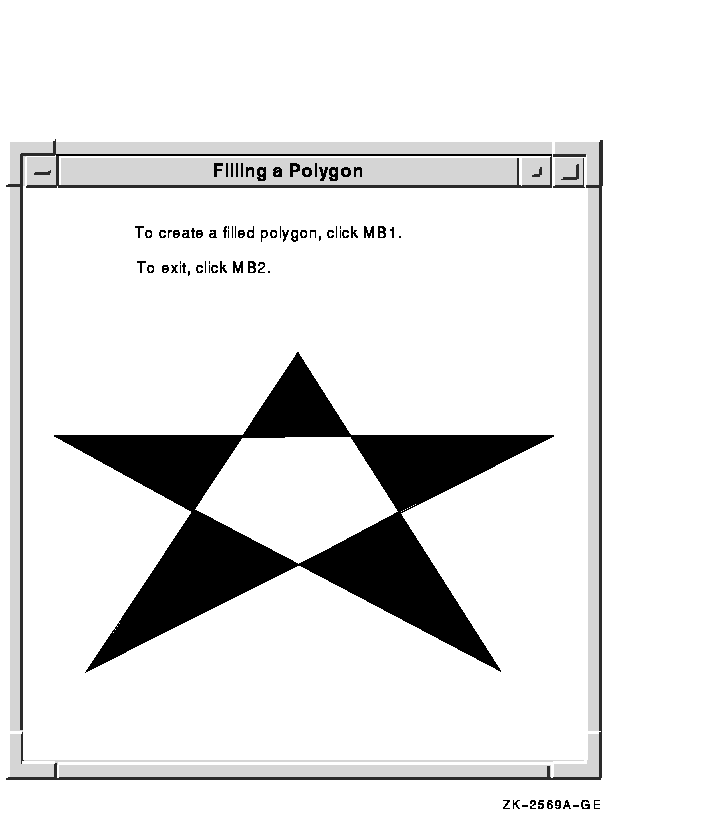
6.6 Clearing and Copying Areas
Xlib includes routines that enable clients to clear or copy a specified
area of a drawable.
Because pixmaps do not have defined backgrounds, clients clearing an
area of a pixmap must use the FILL RECTANGLE routine described in
Section 6.5.1. For more information about pixmaps, see Chapter 7.
This section describes how to clear windows and copy areas of windows
and pixmaps.
6.6.1 Clearing Window Areas
To clear an area of a window, use the CLEAR AREA or CLEAR WINDOW
routine. The CLEAR AREA routine clears a specified area and generates
an expose event, if the client directs the server to do so.
The CLEAR WINDOW routine clears the entire area of the specified
window. If the window has a defined background tile, the window is
retiled. If the window has no defined background, the server does not
change the window contents.
Example 6-6 illustrates clearing a window.
| Example 6-6 Clearing a Window |
.
.
.
/***** Draw multiple arcs *****/
static void doButtonPress(eventP)
XEvent *eventP;
{
#define ARC_CNT 16
#define RADIUS 50
#define INNER_RADIUS 20
XArc arc_arr[ARC_CNT];
int i;
int x = eventP->xbutton.x;
int y = eventP->xbutton.y;
if (eventP->xbutton.button == Button2) sys$exit (1);
if (eventP->xbutton.button == Button3)
{
XClearWindow(dpy, win);
return;
}
for (i=0;i<ARC_CNT;i++) {
arc_arr[i].angle1 = (64*360)/ARC_CNT * i;
arc_arr[i].angle2 = (64*360)/ARC_CNT*3;
arc_arr[i].width = RADIUS*2;
arc_arr[i].height = RADIUS*2;
arc_arr[i].x = x - RADIUS + sin(2*3.14159/ARC_CNT*i) * INNER_RADIUS;
arc_arr[i].y = y - RADIUS + cos(2*3.14159/ARC_CNT*i) * INNER_RADIUS;
}
XDrawArcs(dpy, win, gc, &arc_arr, ARC_CNT);
}
|
The example modifies the doButtonPress routine of
Example 6-4 to clear the window when the user clicks MB3.
To clear multiple areas, using the FILL RECTANGLES routine is faster
than using the CLEAR WINDOW or CLEAR AREA routine. To clear multiple
areas on a monochrome screen, first set the
function member of the GC data structure to the value specified by the
constant GXclear. Then call the FILL RECTANGLES
routine. If the screen is a color type, set the value of the background
to the background of the window before calling FILL RECTANGLES.
|




